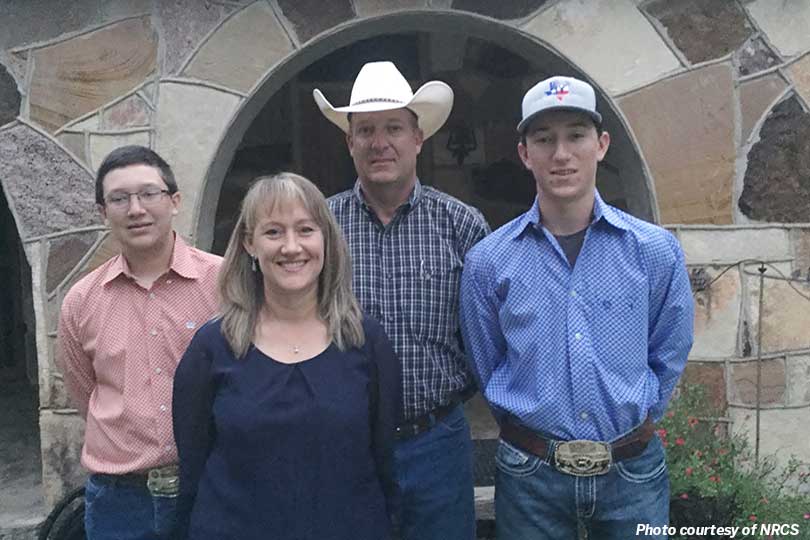By Melissa Blair
NRCS Public Affairs Specialist
Becky Sultemeier and her husband, Shelby, run a Red Brangus cattle operation on their 1,100-acre property which straddles the Travis and Blanco county line near Spicewood, northwest of Austin. The property has been in the family since the 1930s and originally belonged to Becky’s grandparents, Coke and Helen Hollingsworth and dad, Archie Hollingsworth.
In 2013, Shelby stopped by the USDA-Natural Resources Conservation Service’s (NRCS) office in Travis County when he heard the agency could help improve resources on their property. Jeremy Hasty, Travis County NRCS district conservationist, explained how conservation planning and technical assistance works, as well as financial assistance programs, such as the Environmental Quality Incentives Program (EQIP).
“Some of the resource concerns were lack of water for the pastures and cross fences,” Shelby said. “Then, taking into consideration we had a lot of brush that we needed to have removed so we could get the grass reestablished for our cattle operation.”
The first step was to develop a conservation plan. Hasty met Shelby at their property to learn firsthand about the couple’s concerns for livestock water and fencing as they drove around the ranch discussing the Sultemeier’s short- and long-term goals for their operation.
Through NRCS technical and financial assistance, three solar pumping units have been installed. One unit went into an existing well. The other two units were put into new wells drilled through EQIP. At each well, there is a 5,000-gallon storage tank that gravity flows water through a total of 7,400 feet of pipeline to six different 500-gallon water troughs. This system improves water distribution in pastures and use for rotationally grazing livestock. This in turn can reduce overgrazing, soil erosion and allow forage to recover faster, especially during times of drought.
“By coming up with that plan on where we needed to put water sources, what fences needed to be rebuilt, where we could do brush work that was going to benefit the place and now seeing the outcome of the grass growth that we have had in the short period of time is amazing,” said Shelby. “Even the water that you are seeing coming up in some of these draws, is all direct results of working through NRCS and partnering with them to clear brush.”
To more efficiently allocate the grazing, the Sultemeiers installed 6,656 feet of cross fencing. They cleared 84 acres of cedar in one pasture and reseeded it with a native grass mix, followed by a full year of deferred grazing. Now they have little bluestem, side oats grama, yellow Indian grass and switchgrass flourishing in the pasture.
The Sultemeiers’ conservation efforts are also benefiting the Trinity Aquifer, which contributes to the recharge of the Edwards Aquifer. Hasty said, “By installing these conservation practices to improve grass cover in pastures and not overgrazing, it helps catch and hold the rainfall, allowing it to soak in. What does run off will have less sediment in it before it flows into the creeks and eventually the Pedernales River.”
They also participated in the Lower Colorado River Authority (LCRA) Creekside Conservation Program, which is a joint effort between LCRA, NRCS, local soil and water conservation districts (SWCDs) and private landowners and producers. The Sultemeiers finished brush clearing 240 acres of cedar this year through their LCRA contract, in which NRCS provided the technical assistance and planning for the brush work.
“The NRCS programs have enabled us to accomplish some of our long-term plans in three short years,” Becky said. “By working together as a family to complete the programs, with some help from a local contractor, H-5 Land Clearing, we were able to complete the work within the allotted budget. Without the financial assistance, it would have taken us several more years to generate the funds necessary for this work.”
The Sultemeiers are scheduled to install an additional 1,308 feet of pipeline, two 1,000-gallon water troughs, and 6,332 feet of partition fencing to expand their rotational grazing.
“After completion, NRCS’ help will allow us to successfully manage and rotate in a manner that will benefit the ranch, livestock, and wildlife,” Becky added.
Earlier this year, the Sultem

